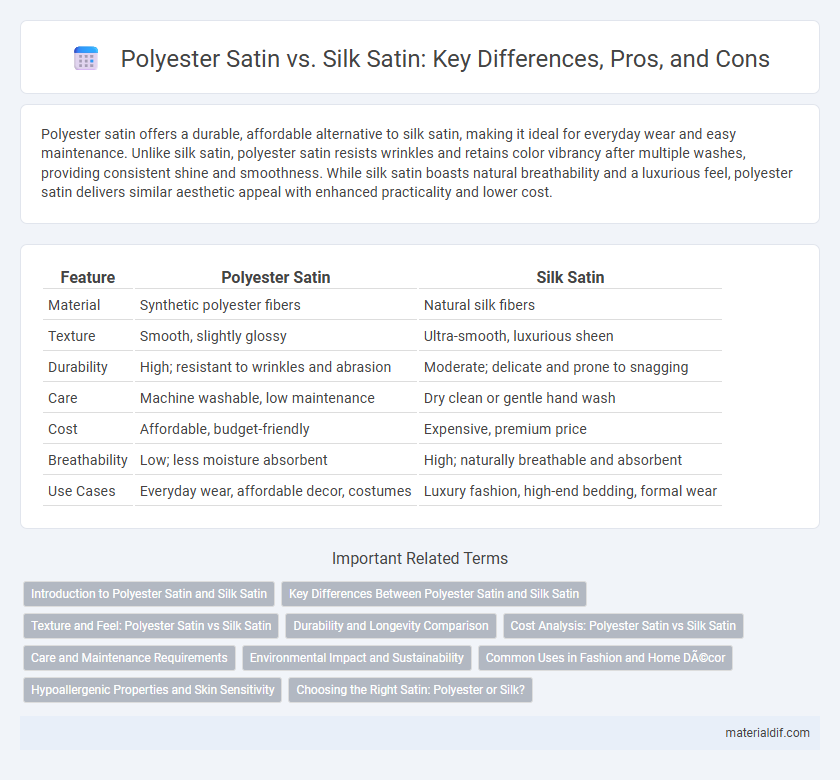Polyester satin offers a durable, affordable alternative to silk satin, making it ideal for everyday wear and easy maintenance. Unlike silk satin, polyester satin resists wrinkles and retains color vibrancy after multiple washes, providing consistent shine and smoothness. While silk satin boasts natural breathability and a luxurious feel, polyester satin delivers similar aesthetic appeal with enhanced practicality and lower cost.
Table of Comparison
| Feature | Polyester Satin | Silk Satin |
|---|---|---|
| Material | Synthetic polyester fibers | Natural silk fibers |
| Texture | Smooth, slightly glossy | Ultra-smooth, luxurious sheen |
| Durability | High; resistant to wrinkles and abrasion | Moderate; delicate and prone to snagging |
| Care | Machine washable, low maintenance | Dry clean or gentle hand wash |
| Cost | Affordable, budget-friendly | Expensive, premium price |
| Breathability | Low; less moisture absorbent | High; naturally breathable and absorbent |
| Use Cases | Everyday wear, affordable decor, costumes | Luxury fashion, high-end bedding, formal wear |
Introduction to Polyester Satin and Silk Satin
Polyester satin and silk satin both feature a smooth, glossy surface created by a specific weave pattern, but differ significantly in fiber origin and performance. Polyester satin is made from synthetic fibers, offering durability, affordability, and resistance to stains and wrinkles, making it ideal for everyday use and budget-conscious consumers. Silk satin, derived from natural silk fibers, provides a luxurious feel, superior breathability, and a lustrous sheen, often preferred for high-end garments and special occasions.
Key Differences Between Polyester Satin and Silk Satin
Polyester satin is a synthetic fabric known for its durability, affordability, and resistance to wrinkles, making it ideal for everyday wear and budget-friendly fashion. Silk satin, derived from natural silk fibers, offers a luxurious feel, superior breathability, and a natural sheen that enhances elegance but requires delicate care. The key differences lie in material origin, texture, cost, and maintenance, with polyester satin being more practical and silk satin prized for its premium quality and comfort.
Texture and Feel: Polyester Satin vs Silk Satin
Polyester satin features a smooth, slightly glossy finish with a synthetic feel that is more durable and wrinkle-resistant, while silk satin offers an ultra-soft, luxurious texture with a natural sheen and exceptional breathability. The tactile experience of silk satin is buttery and lightweight, providing a cooling sensation on the skin, whereas polyester satin may feel heavier and less breathable. Both fabrics present a sleek appearance, but the natural fibers in silk satin provide superior softness and comfort compared to the man-made fibers in polyester satin.
Durability and Longevity Comparison
Polyester satin offers superior durability compared to silk satin, resisting wrinkles, abrasions, and fading more effectively due to its synthetic fiber composition. Silk satin, while luxurious and soft, tends to be more delicate and prone to wear, requiring careful maintenance to preserve its appearance over time. The longevity of polyester satin makes it a cost-effective choice for high-use applications, whereas silk satin's natural fibers provide elegance but may deteriorate faster under frequent use.
Cost Analysis: Polyester Satin vs Silk Satin
Polyester satin offers a significantly lower cost compared to silk satin, making it a budget-friendly option for fashion and upholstery. While silk satin commands higher prices due to its natural fibers and luxurious texture, polyester satin provides affordability without sacrificing the characteristic sheen and smooth surface. The price difference stems from the synthetic production process of polyester versus the labor-intensive harvesting of silk fibers, influencing overall expenses in textile manufacturing.
Care and Maintenance Requirements
Polyester satin requires less delicate care compared to silk satin, allowing machine washing on gentle cycles and air drying without significant risk of damage. Silk satin demands hand washing or dry cleaning to prevent fiber weakening and color fading, with careful avoidance of heat and abrasive detergents. Both fabrics benefit from low-temperature ironing, but silk satin necessitates protective pressing cloths to preserve its natural luster.
Environmental Impact and Sustainability
Polyester satin, a synthetic fabric derived from petroleum, has a higher environmental footprint due to its non-biodegradable nature and energy-intensive production processes, contributing to microplastic pollution and greenhouse gas emissions. In contrast, silk satin, produced from natural silkworm fibers, offers better biodegradability but involves significant water usage and ethical concerns related to sericulture. Sustainable alternatives include recycling polyester satin or opting for organic silk certified for eco-friendly practices to minimize environmental harm.
Common Uses in Fashion and Home Décor
Polyester satin is widely used in fashion for affordable evening gowns, blouses, and linings due to its durability and easy care, while silk satin is preferred for luxury apparel such as bridal wear and high-end lingerie because of its natural sheen and softness. In home decor, polyester satin is popular for curtains, upholstery, and decorative pillows because it resists wrinkles and fading, whereas silk satin is chosen for elegant drapes and cushion covers that emphasize refinement and texture. Both fabrics enhance visual appeal, but polyester satin offers practical benefits, and silk satin delivers an opulent experience.
Hypoallergenic Properties and Skin Sensitivity
Polyester satin is often considered hypoallergenic because it resists dust mites and mildew, making it suitable for individuals with sensitive skin or allergies. In contrast, silk satin, while luxurious and natural, can sometimes cause irritation for those with sensitive or allergy-prone skin due to its protein-based fibers. Choosing polyester satin may provide a safer option for maintaining skin health without compromising on a smooth, satin finish.
Choosing the Right Satin: Polyester or Silk?
Polyester satin offers durability, wrinkle resistance, and affordability, making it ideal for everyday wear and home decor. Silk satin, prized for its natural sheen, softness, and breathability, suits luxury garments and special occasions requiring elegance and comfort. Choosing between polyester and silk satin depends on budget, desired texture, and the garment's end use, with polyester excelling in practicality and silk in premium quality.
Polyester Satin vs Silk Satin Infographic

 materialdif.com
materialdif.com